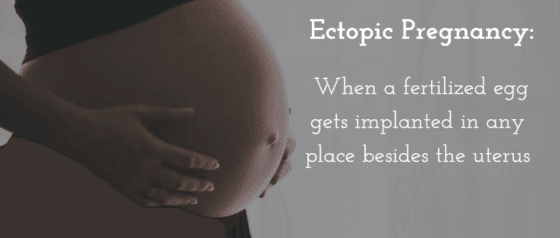A missed period and a $15 home test kit can tell a woman she is expecting, making pregnancy one of the easiest conditions to diagnose. But sometimes things can go wrong even at this early stage. Normally, through an exquisitely delicate process, the fertilized egg makes its way from the fallopian tube and attaches itself to the wall of the uterus (womb) where it develops and grows during the course of the pregnancy. However, sometimes an error occurs, resulting in an ectopic pregnancy.

What is an ectopic pregnancy?
The word ectopic literally means “in an abnormal position.” When a fertilized egg gets implanted in any place besides the uterus, it results in what is known as an ectopic pregnancy. This abnormal attachment most commonly occurs in the fallopian tube, which is why an ectopic pregnancy is commonly referred to as a tubal pregnancy. The fertilized egg may also get implanted at some other abnormal place such as the ovary, the cervix, or another organ in the abdomen. The fetus cannot develop or survive in an abnormal location outside of the uterus. An ectopic pregnancy requires emergency treatment.
The most common symptoms of an ectopic pregnancy are light vaginal bleeding, sharp abdominal pain, nausea and vomiting, dizziness and weakness. However, not every woman experiences these nonspecific symptoms. In fact, many women remain unaware that they are pregnant.
Why is the diagnosis of a tubal pregnancy so important?
If a physician suspects an ectopic pregnancy, they can confirm the diagnosis with a pregnancy test, a pelvic exam, and an ultrasound examination. Treatment for an ectopic pregnancy consists of either a drug called methotrexate or surgery.
Ectopic pregnancy requires immediate medical care. Early diagnosis is essential and can limit the damage. Surgery may be the only option if an ectopic pregnancy is diagnosed at a later stage. Delayed diagnosis of a tubal pregnancy is associated with:
- Higher surgical risks
- Increased likelihood of decreased fertility
- Need to remove one or both fallopian tubes
How common is an undiagnosed ectopic pregnancy?
A retrospective analysis at a teaching hospital found that 12 percent of women presented with an ectopic pregnancy, were initially sent home with an incorrect diagnosis, and subsequently required admission and treatment for a tubal pregnancy. The study also found that delayed diagnosis of tubal pregnancy was associated with a higher rate of salpingectomy (surgical removal of the fallopian tube). Unilateral (one-sided) salpingectomy reduces a woman’s prospects for future pregnancies. Bilateral salpingectomy (removal of both fallopian tubes) renders a woman unable to conceive normally and makes it necessary for her to undergo in vitro fertilization (IVF) in order to get pregnant.
What is medical negligence in diagnosing a tubal pregnancy particularly dangerous?
A fetus can survive for several weeks outside the uterus, but ultimately does not receive the blood supply and support necessary to develop normally. If a physician does not diagnose an ectopic pregnancy in time, the fallopian tube or other structure containing the fetus usually ruptures in 6 to 16 weeks. Although the fetus is not viable at this stage, a rupture is associated with severe bleeding can be life-threatening for the mother. The more advanced the ectopic pregnancy at the time of rupture, the worse is the blood loss and the higher is the risk of maternal death. It is, therefore, the treating physician’s responsibility to diagnose ectopic pregnancy in a timely manner and limit the emotional devastation and physical damage to the mother’s reproductive system.

